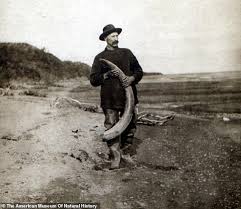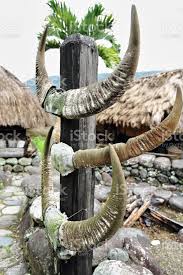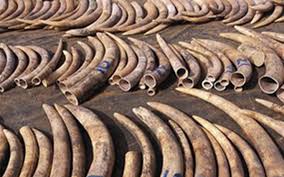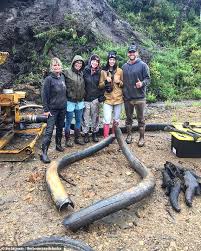Discover the location of thousands of mammoth tusks dumped in the East River by the American Museum of Natural History in the 1940s – sparking a potential property hunt
A bone rush could be underway in New York City’s East River after a Wooly mammoth expert revealed the location where thousands of tusks were reportedly dumped.
Speaking on the Joe Rogan podcast, the gold miner turned bone mogul John Reeves said he wanted to kick off a ‘bone rush’ and mapped out the location of tons of mammoth tusks that could be at the bottom of the East River.
Reeves read from a draft report from the Fairbanks mining District Alaska, which detailed the transportation of thousands tusks from Fairbanks bound for New York City’s American Museum of Natural History in the 1940s.
‘They took 500,000 or so bones from Fairbanks to New York City, left them in the crates… they took about a whole box car load of these bones they ran out of storage and they dumped them in the East River.’
The report specifies that 100,000 of the bones were shipped directly to the museum, suggesting tens of thousands could have been tossed out.
Reeves, who owns thousands of acres of mining grounds in Fairbanks, got a hold of the report from the company he bought, and also spoke to its lead author, Richard Osborne of the University of Alaska.
The report revealed the location of the dumping site at East River Drive and 65th Street.
Wooly mammoth Tusks can go for around $20,000 each depending on their condition, putting the potential value at the bottom of the river at around tens of millions of dollars.
‘If any of you guys want to go out and find some bones I’ll tell you exactly where the f*** they’re at,’ Reeves said as he spelled out the location. ‘They’re finders keepers.’
Some boners, the term used for people who search for valuable bones, have already taken up the call, sharing videos of their trips to the East River.
Citing the draft report, Reeves said that gold miners shipped off 500,000 tusks because the owners saw ‘no value.’
‘You got to remember this was in 1928 to 1958,’ Reeves told Rogan. ‘People, you know miners, didn’t collect the bones.’
According to the report about the tusks, ‘mistakes’ were made over the ‘acceptable condition’ of the bones shipped to New York.
The tusks were ultimately tossed in the river at the former New York City Hospital dumping site.
Reeves said the tusks were dumped by ‘mistake’ along the East River Drive near 65th Street
The revelation has kicked off a bone rush, with fortune seekers already out on the river in search of the tusks, which could fetch $20,000 a piece
All together, the tusks, which were reportedly dumped in 1940s
Although Reeves said the exact method and location of the dump were unknown, he noted that mammoth tusks were dense and would not float away, suggesting they could still be somewhere at the bottom of the river.
Reeves mused: ‘If I was listening to your podcast, and I happen to have a boat, and I happen to have a little scuba equipment?’
Rogan was also enamored by the prospect of the successful bone rush that Reeves was proposing.
‘Do you know how crazy it would be if there’s f****** mammoth bones right there in the East River,’ Rogan said.
‘Dude let me tell you something about mammoth bones mammoth tusks, they’re extremely valuable,’ Reeves replied.
Alaskan miners who saw no value in the tusks allegedly shipped them off to New York City’s American Museum of Natural History. Pictured: Tusks found in 1907 in an Alaskan expedition
Reeves (right) said he wanted to kick off a bone rush. The gold miner has found thousands of preserved bones on his land
Reeves, a self-made millionaire, knows a little something about the value of tusks after discovering perfectly-preserved mammoth bones as he was mining for gold in Alaska.
Reeves, the owner of Fairbanks Gold, LLC, owns thousands of acres of mining grounds along rivers in the state.
In an interview with academic researchers, Reeves described himself as a champion swimmer who went to college in Florida before dropping out and deciding to join prospectors in Alaska searching for gold.
In the 1980s, Reeves bought a gold dredging site outside Fairbanks, which was transformed into a tourist site where visitors could search for gold along the river. The site has since been sold to Holland America.
Reeves moved on to expand his stake in mining grounds in Fairbanks, buying up state and federal land as well.
In a 2012 National Geographic documentary following Ice Age fossil collectors in Alaska, Reeves boasted that he had found thousands of specimens on his land.
While his fellow miners quipped that searching for gold is more lucrative, Reeves said he’s become a passionate collector of the ancient bones.
‘Mammoth tusks are more fun to look at,’ he had said. ‘I like them more than the stacks of $100 bills.’
Since finding Mammoth bones decades ago, Reeves has built up a collection dubbed the Boneyard Alaska that houses his rare specimens
Pictured: Wooly mammoth tusks found on Reeves’ land
The ‘Boneyard Alaska’ documentary, which followed Reeves’ bone searching earlier this year, echoed his passion of searching for ancient bones.
‘I was always captivated by finding something in the ground or in the earth that told me a little bit about our culture and where we came from and what was here before us,’ Reeves said in the film. ‘Those cool things that we find need to be saved.’
In the documentary, Reeves excavations could be seen unearthing 100 bones in a single day, with researchers touting that Reeves could recreate a whole herd of animals with his collection.
Reeves’ collection is notably impressive because the permafrost in Alaska keeps the specimens perfectly preserved.


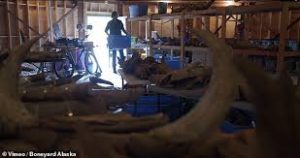
Hits: 1
